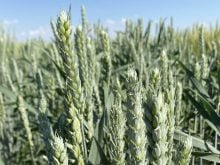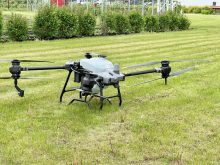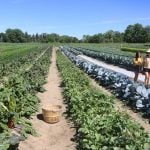It is a relatively small agricultural sector that is stirring a huge and passionate debate.
A small group of Saskatchewan farmers produce deer and elk to send to hunt farms where wealthy hunters — usually American — pay plenty to shoot a “trophy” animal.
In neighboring provinces, some animals are shipped to American hunt farms.
The Saskatchewan government, alone among western provinces, encourages the industry and the millions of dollars it can earn.
But the opponents are legion. Most traditional hunters, animal rights advocates and wildlife biologists insist the hunt farm industry is an abomination that should be stopped.
Read Also

Maritime biofuel regulations could increase crop prices
The International Maritime Organization is proposing a new regulation that would provide an enormous boost to global biofuel demand, which would have a tremendous impact on demand for crops like corn, soybeans and canola.
It is an emotional debate being played out across North America.
In this special report, Saskatoon-based reporter Ed White examines a debate filled with passion, core values, economics and political minefields.
Ten years ago, Ron Friesen became a deer farmer. It allowed him to abandon the itinerant life of a city-based construction worker and move his family to the country near Warman, Sask.
It also allowed him to become a farmer without the huge amounts of money, equipment and land needed to set up a grain farm.
Today, his successful operation provides a good, healthy farm living.
“For a lot of the people in the industry, it’s meant keeping the family farm alive,” said Friesen on a frosty spring afternoon as he looked down a pasture at a group of his shy and skittish white-tailed deer.
It’s also one of the few sectors of prairie agriculture that is doing well, providing producers with steady returns.
But it is a sector embroiled in controversy, facing an uncertain future.
The basis of the deer industry, including Friesen’s farm, is to provide bucks to hunt farms. Now, the legitimacy of hunt farms is under attack.
The debate provokes a level of passion and outrage unseen in other agricultural sectors. Animal rights activists and traditional hunters are lobbying hard to restrict and roll back legalized hunting behind fences.
Hunt farms are so controversial that governments that normally embrace economic opportunity, such as Alberta,
have shown no interest in permitting them.
City-based provincial governments, such as Manitoba’s, have recoiled from the industry, making clear it is not welcome.
This has left Saskatchewan as the only welcoming province in Western Canada.
Though there are only a couple of dozen hunt farms in Saskatchewan, promoters say the potential is huge. For 1999, the provincial government reports 14 game ranches earned about $14 million in revenue.
Next to government policy and political opposition, the biggest obstacle is lack of raw product.
Michigan hunt farm operator Doug Roberts recently told the Saskatchewan Whitetail and Mule Deer Producers Association that game farming in American states like Michigan and Pennsylvania is a booming, growing business restricted only by a lack of deer and elk to shoot.
At the association’s convention, producers said the same problem exists in Saskatchewan. Wealthy people want to come to shoot a farmed deer, but there are far too few deer to go around.
The reason some prairie farmers are interested in operating hunt farms is obvious — a hunter will commonly spend $15,000 on a trip to a hunt farm. Prices of $3,000 to $5,000 for an elk or deer are common.
Many elk producers who are raising the animals mainly for antler velvet, want to see the hunt industry grow in Saskatchewan and expand to other prairie provinces because it gives them a lucrative market for tired old bulls.
For deer producers, the need for hunt farms is even more pressing.
“If there is no hunt industry, there is no whitetail industry,” said Friesen. “It really is the reason to be in this business.”
A deer carcass is worth only about $200 in meat. As a trophy animal, it can be worth $1,000 to $5,000.
South of the border, many states allow hunt farms, but some also have outlawed them.
In some states, including Montana, there is a growing movement to get rid of existing hunt farms.
Especially in the western United States, a backlash against hunt farming is occurring among people who moved there because of their love for the western wilderness.
Though opponents make a wide variety of arguments, much of the outrage boils down to one fundamental objection — it is morally wrong for humans to domesticate a wild animal so it can be shot for fun and profit.
It’s an issue that has pitted some farmers’ desire for a lucrative economic opportunity against deep spiritual values underpinning North Americans’ idealization of wildlife. It clashes with notions of a boundary between wilderness and human civilization and collides with deep-set feelings of how humans and animals should interact.
“It is an attempt to turn the killing of a domesticated animal into a sport,” said Rob Sinclair, who has organized a national anti-hunt farm campaign in Canada for the Inter-national Fund for Animal Welfare.
“It’s like shooting something on the top of a billiard table.”
Urban-based groups like the IFAW and humane societies have long fought against legalizing hunt farms, but the strongest, most vocal and dedicated opponents have been hunters themselves.
Groups like the Saskatchewan Wildlife Federation and the Alberta Fish and Game Association — groups that represent the average prairie hunter — have lobbied hard to ban hunt farms.
To Friesen, the opposition is hard to understand.
Farm families with cattle often shoot a steer in a pen so they can have a full freezer of beef. No one objects to that, he said.
“That’s farming.”
As long as a domesticated animal, including one of his deer, is treated humanely, what is the problem?
“The question is, is it OK for me as a farmer to make more money by letting someone else shoot it? The only difference is someone else pulls the trigger.”
Friesen answers his own question: “It doesn’t make any difference. It’s still a farmed animal being killed.”
But this practical, unromantic approach doesn’t address the deep moral revulsion opponents feel.
Lorne Scott, executive director of the Saskatchewan Wildlife Federation and a former Saskatchewan environment minister, said hunt farms using domesticated deer and elk are an abomination and a foul perversion of what hunting is supposed to be about.
“Hunters view elk as majestic creatures in the wild,” he said.
“Nothing symbolizes wilderness more than a bugling elk on a frosty fall morning, and to think that these animals are enclosed in a compound, fed out of a trough, fed artificial feed, and put behind a fence so there’s no escape ….” His voice trailed off in disgust.
Opponents commonly describe hunt farms as “vile,” and describe what these farms offer as “canned hunting,” “penned hunting,” and “captive hunting.”
Hunt farm operators say their animals have huge, rugged areas in which to hide and are often more difficult to hunt than animals in unfenced wilderness.
Recently, Manitoba government MLAs have given clear signals that they do not intend to legalize hunt farms and have let deer and elk producers know what they think of the hunt farm industry they want to supply.
“This stupid practice of shooting penned animals runs absolutely counter to the tradition and history of our province,” said NDP MLA Stan Struthers when the issue was discussed last fall.
Alberta lying low
While some members of the Alberta government support allowing hunt farms, agriculture minister Ty Lund has said he is not interested in legalizing it unless there is widespread public support and has no plans at present to change the situation.
While the debate often involves
arguments between hunters, anti-hunters and affected farmers, scientists also have had their say.
Across the West, provincial environment departments and biologists have opposed hunt farms.
In 1998, when Saskatchewan was developing regulations for the rapidly growing game farm industry, University of Saskatchewan wildlife biologist Stuart Slattery co-authored an article in a nature magazine called The Blue Jay. The article argued the industry is a threat to wild populations of native species, not just through disease and the fencing of large areas of wildlife habitat, but also because it cheapens and commercializes the idea of wildlife.
“On philosophical grounds, turning native animals into, essentially, another species of privately owned cow may trivialize wild animals and reduce public interest in wildlife and support of wildlife-oriented programs,” the article said.
It complained that spiritual and conservation issues are being overwhelmed by economics as farmers look desperately for a way to make money to keep farms viable.
“When dealing with agricultural issues, one road block conservationists may face is that industry representatives either ignore or fail to understand that wildlife and wild places have intrinsic value and that healthy ecosystems provide many environmental benefits ….”
The article argued that the debate cannot be reduced to simple economics.
“The political process currently being used to promote game farming in Saskatchewan appears to be economically oriented and conservation disoriented.”
Still, proponents of the industry say economics is important and that hunt farms offer a service that is in demand.
The demand for these expensive hunts comes from wealthy American businesspeople.
Though the popularity of sport hunting has declined, trophy hunting is considered a noble pursuit in the corporate world, a chance for office-bound men to demonstrate their virility.
For them, money is not the prime obstacle to hunting. Time is the problem.
Most can get away from work only for a few days, so they want to be able to fly in, be guaranteed a trophy animal kill and then get back to work with an impressive head to hang on the wall.
Hunt farm operators say these hunters bring a lot of money to the Prairies, offering a needed boost to the beleaguered rural economy. This is money that would otherwise stay in the cities rather than make it into prairie farmers’ pockets.
But the very nature of these hunters appears to be another bitter pill that sticks in the craw of the traditional prairie hunter.
“There are people from New York City who will pay $5,000 to $10,000 to shoot an animal behind a closed fence and take back the head and hang it up and say they shot it up there in the Canadian wilderness,” said Scott.
“No one in New York City would be any the wiser.”
Christopher Lind, a United Church ethicist at St. Andrew’s College at the University of Saskatchewan, said the powerful feelings aroused by the issue of hunt farms occurs because people have different views on how humans and animals should interact.
“You can’t understand that kind of ethical conflict unless you understand the different world views that support those positions,” said Lind.
The debate on the Prairies and in the western United States is especially intense because hunt farms there are relatively new, he said.
In other parts of the world such as Africa, this kind of activity has been practiced for a long time. In the ancient world, kings built royal enclosures where they would kill animals driven toward them by servants. Often the royal hunters did their killing while sitting on a throne.
That isn’t the tradition in Western Canada.
“You get a lot of passion in those kinds of conflicts of world view because there’s no obvious way to resolve them,” Lind said.
“You have to deeply understand the different worlds in which people live and that’s exactly what you’ve got here, different worlds.”
A man sitting uncomfortably between these conflicting worlds is Pense, Sask., cattle breeder John Willmott. He is president of the Regina Humane Society, which has formulated a national anti-hunt farm policy, but he has mixed feelings about the issue.
“I’m a farmer to begin with, so I see both sides of the equation,” Willmott said.
The humane society’s official policy opposes hunt farming because “captive hunting robs animals of their inherent honor, dignity and respect.”
Willmott doesn’t entirely agree with his society’s description of animals’ “inherent” characteristics, and is also wrestling with the ethics of hunt farms.
He instinctively recoils at the idea of captive animals being shot for entertainment, but wonders if that is enough reason to legally ban the practice.
“If I go out there and start picking off gophers, is that any different?” he wondered on a recent day when his dogs were off hunting local ground squirrels.
Willmott believes hunt farms can be ethically allowed, but only if they are subject to stricter rules, regulations and codes of practice.
His grudging acceptance of hunt farms comes from his belief that hunt farm animals are generally killed in a humane manner and that humane slaughter is the central issue.
But he said that’s where the split comes among animal welfare people. Many of his colleagues at the humane society believe that killing a domestic animal for sport and entertainment is morally wrong and encourages inhumanity to animals.
The humane society is not opposed to hunting in the wilderness, but doesn’t like to see it on a farm.
However, the Saskatchewan Society for the Prevention of Cruelty to Animals restricts itself to judging whether or not the animals die humanely.
“Their feeling was that if the killing of the animal on the hunt farm is humane and final, and there are certain rules and regulations that they have to follow, that they wouldn’t be opposed to it,” said Willmott, who is also an SPCA member.
Scott said his organization’s members are opposed to hunt farms as a matter of principle, not because they feel hunt farm animals suffer.
“From the animal’s perspective, it probably wouldn’t matter whether it was shot in the porcupine forest out in the wild or was shot in a game farm because the animal will be dead,” said Scott.
“But it’s just the philosophical, ethical view that people have.”
The industry’s future on the Prairies and in North America is unclear. While it is growing in places like Saskatchewan and Michigan, it is stalled in places like Manitoba and may be reversed in Montana.
Mike Kilpatrick, president of the North American Elk Breeders Association, said Montana residents will vote in November on whether to outlaw hunt farms.
He is not hopeful of the result.
“My true, honest answer is that (the ban) will pass,” said Kilpatrick.
“If this goes to the ballot box, I’m scared.”
Though the Saskatchewan government has allowed the industry and is strongly supporting hunt farm growth, Willmott said he doesn’t think the issue will fade.
“I don’t think that this will be resolved. There will always be people in favor and people strongly opposed.”
It will be for governments across North America to find the balance between those warring camps.















